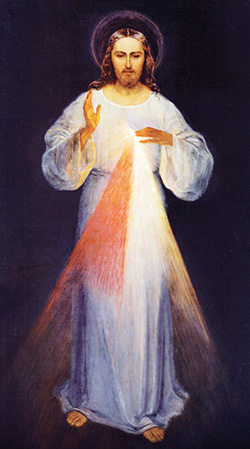Sight Unseen / Brandon A. Evans
Up through the rays of mercy
 It’s interesting that in the visions received by the 20th-century saint, Faustina Kowalska, she records the words of Jesus as saying that he offers the world an “ocean of mercy.”
It’s interesting that in the visions received by the 20th-century saint, Faustina Kowalska, she records the words of Jesus as saying that he offers the world an “ocean of mercy.”
If we believe her vision to be true, then that phrase in particular has at least two ramifications.
One is that the unearned kindness that Christ offers each of us far exceeds even our wildest imaginings, more than the sea exceeds the shore.
No matter how many times I’ve been to the ocean, I’m always struck by how much bigger it is than even my crisp memories can conjure. That endless horizon of blue—and the dark depths beyond—silence any attempt to quantify it.
The waves, even in calmer waters, scatter sand and shell from between our toes to the ends of the world.
In the same way, the slightest portion of God’s mercy tosses away the sins of everyone who has ever lived—all the horrible cruelty, pride and indulgence are swirled away as if nothing.
Forgiveness is only mercy’s start.

This original painting of the Divine Mercy by Eugeniusz Kazimirowski was made in 1934 while St. Faustina Kowalska was alive. The image was based on visions she had received of Jesus, who implored her to share with the world a message of mercy. (Creative commons license)
The vision that St. Faustina saw—of a meek Christ letting flow rays akin to blood and water from his heart—hides a far deeper strength.
For if in those gentle lines truly runs an ocean, then there is something else that must be true: the sea does not just crash waves onto the shore only from its vast reserves, it also draws out the water first.
Christ did something remarkably similar in his life, particularly in his supreme act of redemption, whereby the sins of man hunted down the Son of God.
On the cross, despair and divinity met, and both were vanquished.
Or so it seemed.
In truth, divinity surrendered to despair, allowing evil not to meet the justice of God, but rather his mercy.
Thus, forevermore the limit of evil became mercy, as St. John Paul II once noted.
All darkness and death meet their ends and bear their opposites in the merciful heart of Jesus—a heart so overflowing with abundance that rays invisible become conduits to us of grace and goodness.
And conduits work both ways.
Just as the sea draws out water, those same divine rays must surely draw up shadow and transform it to light, the same as transpired between Good Friday and Easter Sunday.
While the ongoing redemption of the world may work in such a way, Divine Mercy is so much more personal than that. It’s not a vague, mechanical process: it’s a conversation. The One who heals is also the One who hears. His channels don’t just shine down, they shine up.
We may even imagine sending along the rays of scarlet our pains unescapable, and along the white our dreams unattainable.
The things that we don’t believe we deserve—or even expect—an answer to.
The things a person casts, at last resort and in surrender, to the feet of a Savior.
As such it’s probably not a coincidence that the same image Faustina gave us also bears in each language the words, “Jesus, I trust in you.”
He wants us to entrust to his mercy our deepest wounds and truest aspirations, that the two, running up through those lines of crimson and light, may in the heart of Jesus finally meet, and there find both redemption and peace; eventually flowing back down to us—in this life or the next—as bindings made loose and hopes made whole.
(Sight Unseen is an occasional column that explores God and the world. Brandon A. Evans is the online editor and graphic designer of The Criterion and a member of St. Susanna Parish in Plainfield.) †
 It’s interesting that in the visions received by the 20th-century saint, Faustina Kowalska, she records the words of Jesus as saying that he offers the world an “ocean of mercy.”
It’s interesting that in the visions received by the 20th-century saint, Faustina Kowalska, she records the words of Jesus as saying that he offers the world an “ocean of mercy.”